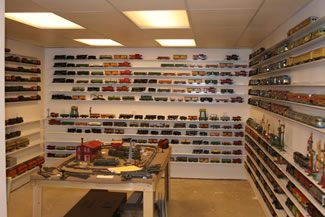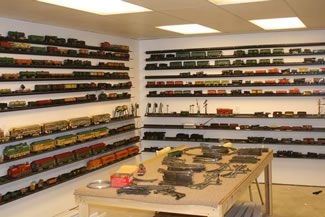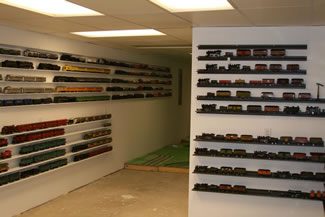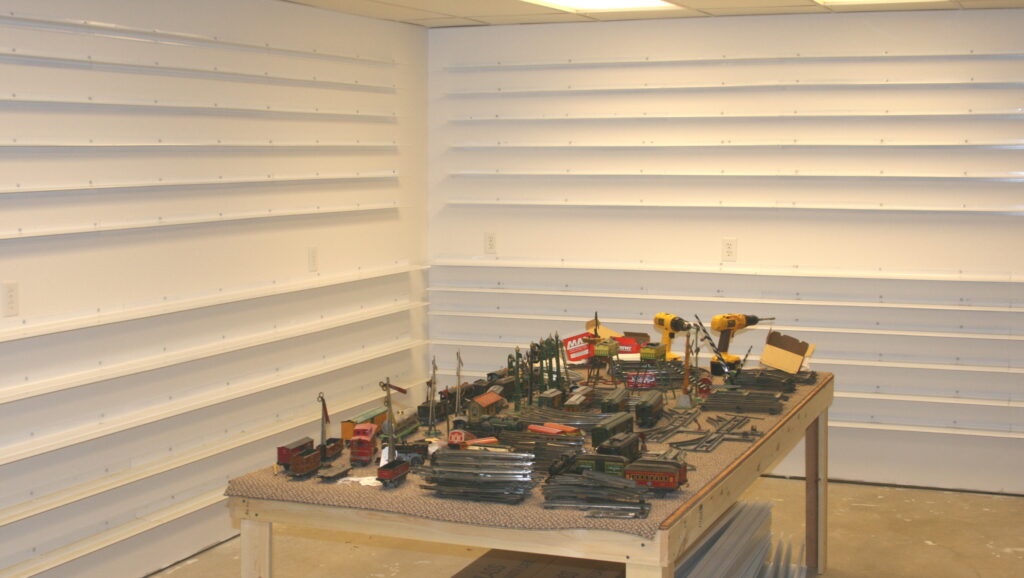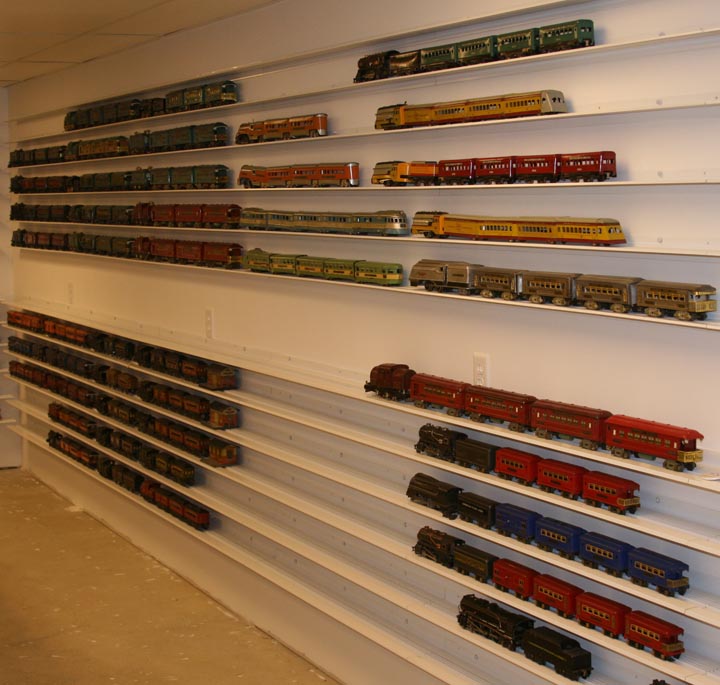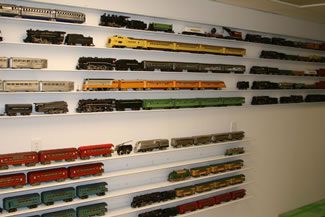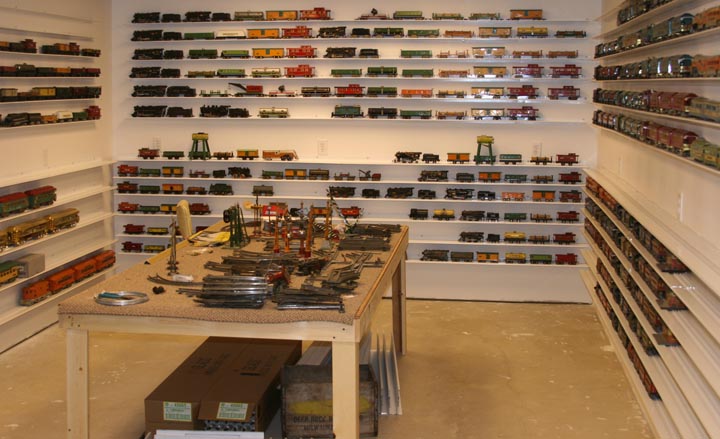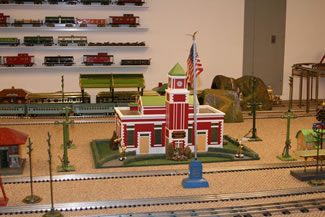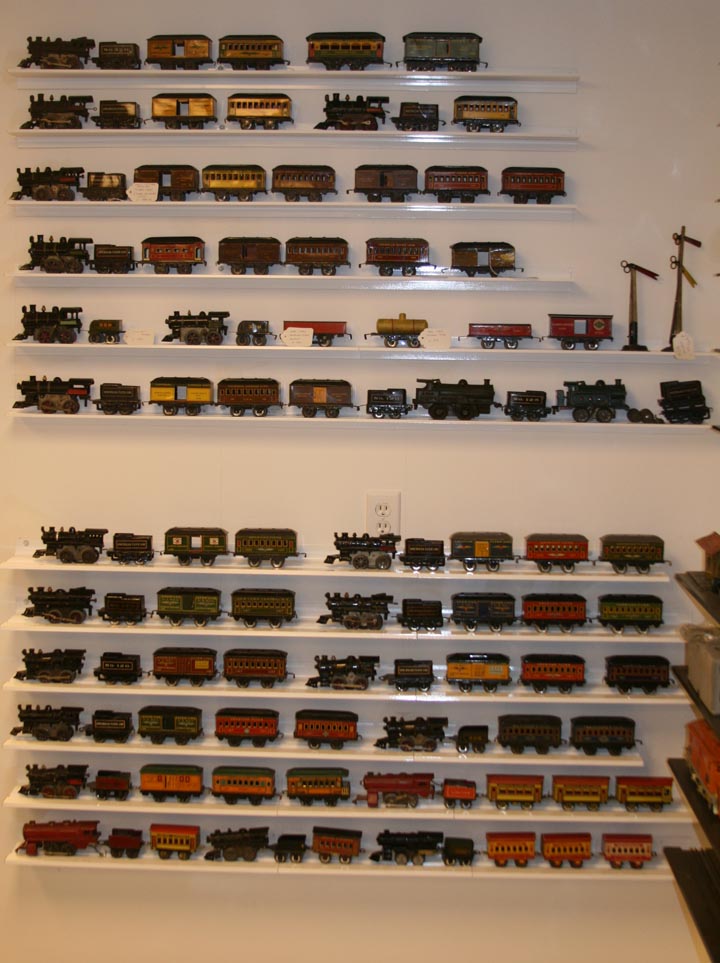Train Shelving Options
By Leon Sweet
This article stems from a conversation I had with e*Train Editor Bob Mintz. He indicated that he had just purchased some train shelving for his collection. I related to him my experience with buying train shelving, which is as follows:
While at York in the Fall of 2008, I talked with a number of manufacturers of aluminum train shelving and surveyed their prices. The price of shelving that would accommodate O gauge trains was running a minimum of $4 per linear foot plus shipping. At that time, I was still uncertain of what I wanted and how much shelving I would need, so I sat back and waited.
Two weeks after York, my thoughts on train shelving suddenly shifted into high gear. I had received an email from Stout Auctions reminding me of their auction in Williamsport, Indiana the next day. I went through their on-line catalog and discovered that there were 4 lots of used aluminum train shelving at the end of the auction, with the covenant that it had to be picked up and they would not ship it. I thought that the fact that they would not ship the shelving may cause it to sell at a bargain price. Luckily I have a very flexible work schedule so I was up early the next morning, driving to the auction.
I surveyed the 4 groups of shelving and was surprised to find that the groups were divided into two different colors of the shelving (white and brown) and two different sizes (up to O gauge and O gauge to Standard Gauge). The one thing I was certain about is that the shelving was the same type as the 175 feet of used brown shelving I had purchased in 2005. I waited for the end of the auction, when the shelving was scheduled to sell and bought all 4 groups of shelving, figuring I could always sell off the excess shelving. After the auction Greg Stout said that he was not sure it would sell, but that as a condition of selling the particular collection associated with the shelving, the widow made them take the shelving.
Now that I had purchased the shelving it was a matter of getting it home. I stacked it floor to ceiling in the back my Pontiac Vibe (with the rear seats folded down) and ended up stacking some of it on the passenger seat in the front. Needless to say, my car was packed full as I drove out of the lot. I later determined that I had hauled approximately 900 feet of shelving home that day and currently have a total of 1,044 feet of aluminum shelving, with me recycling some lengths that were less than 1-foot long (which I felt were unusable due to their extremely short lengths).
I was correct in my assumption that the shelving on the Stout auction may be able to be purchased at a bargain price and my initial purchase price was about $1 per linear foot of shelving.
Buying used shelving can be an inexpensive option for collectors, but may not be for everyone. I discovered that the used shelving that I purchased is “TRAINSHELF” brand that is manufactured by Dick Wachtman, TCA 83-19962 and was initially sold in 4 foot lengths, but some of the shelving I purchased had been cut into smaller lengths. I discovered that the former owner must have had their shelves in groups of 6 shelves, as all of the shorter lengths came in groups of 6. Although I thought the cut sections may cause problems with installation, these smaller lengths actually worked in my favor. The walls in my basement were not perfect for 4 foot lengths, so some of the smaller lengths, when combined with the 4-foot sections were great for creating the perfect shelving lengths for my walls.
The biggest issue with my used shelving was discovered only after I had mounted it on the walls. As I mentioned, some of the shelving was white and some of the shelving was brown. I unfortunately put the brown shelving on the walls first. As I put the first train on the white shelving, I immediately noted that the shelving seemed to disappear on the white wall and all I noted was the train, as opposed to the brown shelving, where the shelving stood out and the trains did not.
My next trip to York, I happened upon Dick Wachtman’s booth in the Orange Hall and spoke with him about the shelving I had purchased. I mentioned the white and brown shelving and he indicated that he had only produced two groups of white shelving and that it was special order only. He questioned me about the shelving and I indicated I had some standard gauge shelving and he told him that he knew who the original owner was. My questions to him related to the finish on the shelving, as I thought it was an anodized finish. He mentioned that his early shelving was painted either brown or white and was not anodized like the later produced shelving, due to the high cost of anodizing in the early years of production.
This was a big relief for me, as I knew that refinishing the painted shelving would be easier for me. In 2009, I began the major project of taking the brown shelving off the walls, sanding the shelving to rough up the paint, priming the shelving and painting the shelving white. I set up a paint booth in half of my garage and did one wall at a time. It took me all summer to do the three walls of brown shelving and a 4th group that was not yet mounted to the wall.
All I can say about the shelving is that once I repainted the shelving and re-mounted it on the wall, it looks great.
I am very happy with my efforts on repainting the shelving and it looks terrific and was an inexpensive option for my shelving needs.
One last tip for mounting the shelving: To mount the shelving to the walls, I purchased screws that are commonly used to mount steel siding to pole barns. These screws are great for this application as they fit into socket heads and have a rubber grommet between the head and the siding (shelving). What is perfect about these screws is that I was able to purchase them in large boxes at the local home improvement store. Additionally, the screws were already finished white, which is a great match to the white shelving.

